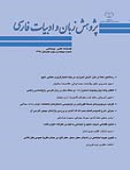التقای واکه میان پیشوند استمرار /mi-/ و ستاک حال در زبان فارسی: واجشناسی زایشی
محورهای موضوعی : پژوهشهای ادبیات کلاسیک ایرانشهین امیرجانی 1 , عالیه کرد زعفرانلو کامبوزیا 2 , آرزو نجفیان 3
1 - دانشگاه آزاد- قم
2 - علوم انسانی
3 - پیام نور
کلید واژه: واجشناسی زایشی فرآیندهای واژ- واجی پیشوند استمرار کوتاهشدگی واکه ارتقای واکه,
چکیده مقاله :
هدف از نگارش مقاله حاضر، شناسایی و توصیف فرآیندهای واژ- واجی موجود در فعلهای سادۀ واکه آغازین زبان فارسی معیار، پس از افزودن پیشوند استمراری «می» /mi-/ است. روش پژوهش، توصیفی- تحلیلی است. در این پژوهش، درروش گردآوری دادهها، از 323 ستاک حال بر اساس طباطبائی (1376)، فرهنگ دهخدا (1390) و فرهنگ سخن (1382)، 50 فعل وجود دارد که با واکه آغاز میشوند. دادهها بر اساس الفبای آوانویسی بینالمللی «آی، پی، ای» آوانگاری شده و سپس در چارچوب نظریه واجشناسی زایشی تحلیل میشوند. نتایج نشان میدهد که در زبان فارسی در ابتدای فعلهایی که با واکه آغاز میشوند در روساخت گفتار رسمی «همزه» یا انسداد چاکنایی [ʔ] درج میشود. پس از افزودن پیشوند استمرار/mi-/، دیگر «همزه» در گفتار غیررسمی درج نشده و بهجای آن فرآیند کوتاه شدگی واکه پیشین، افراشته /i/ بهصورت، توالی واکه کوتاه و غلت [-ej-] رخ میدهد. سپس ارتقاء واکه پیشین، میانی [e] در محیط پیش از غلت [j] بهصورت توالی واکه و غلت[-ij-] مشاهده میشود. در چنین ساختهایی دیگر «همزه» در التقاء واکه در گفتار غیررسمی مشاهده نمیشود.
It is important to analyze the lexicological-phonological processes of the present stem in order to evaluate the generative capacity of each phonological process. The present article aims to identify and describe the lexicological-phonological processes in simple verbs with the initial vowel of standard Farsi after adding the continuous prefix / mi/. The research method is descriptive-analytical. In this research, in the method of data collection, there are 50 verbs out of 323 verbal roots based on Tabataba'i (1997), Dehkhoda Dictionary (2011), and Sokhan Dictionary (2003) which begin with vowels. The data have been transcribed according to the International Phonetic Alphabet "I.P.A" and then analyzed in the framework of generative phonological theory. Results show that in written or formal Farsi, "Hamza" or the glottal stop [ʔ] is added to verbs that begin with vowel and for this reason, they begin with "A"; but after adding the continuous prefix / mi- /, "Hamza" is not inserted in the spoken or informal Farsi and instead, the front vowel shortening process, raising /i/ and gliding as short vowel sequence and gliding [-ej-] and then raising the front central vowel [e] before gliding [j] as vowel sequence and glide [-ij-] are observed. In such structures, in the informal speech, there is no "Hamza" or the glottal stop [ʔ] in the verb structure.
